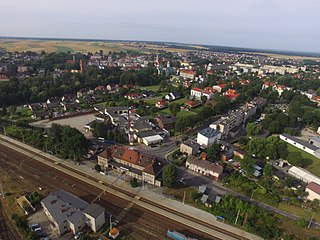
Bytom is a city in Upper Silesia, in southern Poland. Located in the Silesian Voivodeship of Poland, the city is 7 km northwest of Katowice, the regional capital.

Czerwionka-Leszczyny is a town in Silesian Voivodeship in southern Poland. It is the only town in Rybnik county and the seat of the larger Czerwionka-Leszczyny municipality which also includes 6 villages. Czerwionka-Leszczyny was created by a merger of two towns and two villages, which to this day maintain their separate identities. As of December 2021, the town has a population of 27,683.

The Upper Silesia plebiscite was a plebiscite mandated by the Versailles Treaty and carried out on 20 March 1921 to determine ownership of the province of Upper Silesia between Weimar Germany and Poland. The region was ethnically mixed with both Germans and Poles; according to prewar statistics, ethnic Poles formed 60 percent of the population. Under the previous rule by the German Empire, Poles claimed they had faced discrimination, making them effectively second class citizens. The period of the plebiscite campaign and inter-Allied occupation was marked by violence. There were three Polish uprisings, and German volunteer paramilitary units came to the region as well.

Olesno is a town in Opole Voivodship, Poland about 42 kilometres (26 mi) north-east of the city of Opole. It is the capital of Olesno County and seat of the Gmina Olesno.

Jankowice is a village in the administrative district of Gmina Pszczyna, within Pszczyna County, Silesian Voivodeship, in southern Poland. It lies approximately 4 km north-east of Pszczyna and 28 km south of the regional capital Katowice.

is a village in Gmina Hażlach, Cieszyn County in Silesian Voivodeship, southern Poland.

Ochaby is a sołectwo in Gmina Skoczów, Cieszyn County, Silesian Voivodeship, southern Poland. It consists of two villages: Ochaby Wielkie and Ochaby Małe. It is known from a large horse stud farm, one of the largest in Silesia.

Bielowicko is a village in Gmina Jasienica, Bielsko County, Silesian Voivodeship, southern Poland.

Świętoszówka is a village in Gmina Jasienica, Bielsko County, Silesian Voivodeship, southern Poland. It lies in the Silesian Foothills in the historical region of Cieszyn Silesia.

Golasowice is a village in the administrative district of Gmina Pawłowice, within Pszczyna County, Silesian Voivodeship, in southern Poland. It lies approximately 5 kilometres (3 mi) south-west of Pawłowice, 20 km (12 mi) west of Pszczyna, and 43 km (27 mi) south-west of the regional capital Katowice.
The Silesian People’s Party was a political organization in Cieszyn Silesia that existed from 1909 to 1938 in Austrian Silesia, which later became international plebiscite territory and finally part of Czechoslovakia. The party included mainly Slavic people, who saw themselves as members of a Silesian nation. The party is seen as part of the Szlonzakian movement or Silesian Separatist Movement.

Hołdunów is a district of Lędziny, Silesian Voivodeship, southern Poland. It was established in 1770 and merged with Lędziny in 1991. At the end of 2014 it had 5,399 inhabitants.

Bzie is a sołectwo in the south-east of Jastrzębie-Zdrój, Silesian Voivodeship, southern Poland. It was an independent village but became administratively part of Jastrzębie-Zdrój in 1975.

Godula is a district in the north-east of Ruda Śląska, Silesian Voivodeship, southern Poland. It has an area of 1.8 km2 and in 2006 it was inhabited by 12,151 people.

Orzegów is a district in the north-east of Ruda Śląska, Silesian Voivodeship, southern Poland. It has an area of 2.5 km2 and in 2006 it was inhabited by 8,439 people.

Chropaczów is a district in the north-east of Świętochłowice, Silesian Voivodeship, southern Poland. In 2013 it had a population of 12,589 people.
The German–Polish Convention on Upper Silesia, also known as the Geneva Convention of 15 May 1922, dealt with the constitutional and legal future of Upper Silesia, part of which became Polish territory after the 1921 Upper Silesia plebiscite.

Sucha Góra is the northernmost district of Bytom, Poland.

Beuthen District, or Beuthen Rural District was an Upper Silesian rural district with its seat in Beuthen, which itself was a separate district - an urban district.

Silesian independence is the political movement for Upper Silesia and Cieszyn Silesia to become a sovereign state.

















